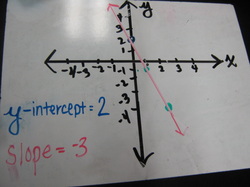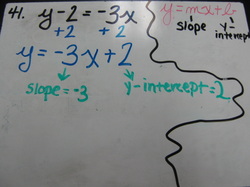When writing an equation for a perpendicular line, there are some things that you need to remember. First, remember that lines that are perpendicular have slopes that are negative reciprocals. Perpendicular lines should always form a right angle. So, if they don’t form a right angle you know something is incorrect.
When writing an equation for parallel lines, you need to know that the parallel lines have the same slope. Parallel lines have to have different y-intercepts in order to be parallel. Any two vertical lines are parallel.
Here are the three types of linear equations we have studied so far during Unit 6:
y=mx+b is the slope intercept form.
An example would be: y=3x+4
Ax+By=C is the standard form.
An example would be: 4x+7y=19
(y-y1)= m(x-x1) is the point slope form.
An example would be: y-3=-2/3(x-9)
Step 1: First you write the original problem.
Step 2: You have to add 2 to both sides to make it look like the equation needed to find slope and the y- intercept.
Step 3: re‐write the problem.
Step 4: The y‐intercept would be 2 and the slope would be -3.
Step 5: Then graph
This is your new blog post. Click here and start typing, or drag in elements from the top bar.
When we learned Lesson 6–2, we found it helpful to know these vocabulary terms:
Linear Function- A function that graphs a line
Parent Function- The simplest equation of a function
Linear Parent Function- The equation y = x or f(x) = x
Linear Equation- An equation that models a linear function
y‐intercept- y‐coordinate of the point where a line crosses the y‐axis
Slope‐Intercept Form- y = mx + b


 RSS Feed
RSS Feed